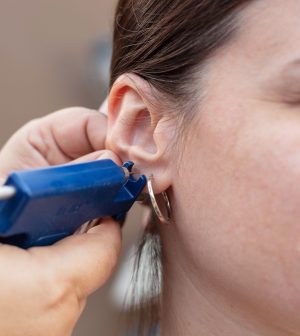- Navigating Your Midlife Crisis: Embracing New Possibilities
- City Raccoons Showing Signs of Domestication
- Mapping the Exposome: Science Broadens Focus to Environmental Disease Triggers
- One Week Less on Social Media Linked to Better Mental Health
- Your Brain Changes in Stages as You Age, Study Finds
- Some Suicide Victims Show No Typical Warning Signs, Study Finds
- ByHeart Formula Faces Lawsuits After Babies Sickened With Botulism
- Switch to Vegan Diet Could Cut Your Greenhouse Gas Emissions in Half
- Regular Bedtime Does Wonders for Blood Pressure
- Dining Alone Could Mean Worse Nutrition for Seniors
How to Care for a New Body Piercing

Piercings can be a fun way to express yourself, but they can also cause complications — particularly in areas that aren’t the earlobes — and need proper care.
“The first step to caring for your piercing is choosing a qualified piercer,” said Dr. Steven Daveluy, an associate professor and program director at Wayne State Dermatology in Michigan. “Select an experienced piercer in a licensed studio. Then, properly care for your new piercing afterward to prevent problems, such as an infection or your piercing closing.”
Daveluy and the American Academy of Dermatology offer these recommendations that people can follow to help ensure piercing success.
- Leave your jewelry in. Don’t remove your new piercing for six weeks or more, even at night. The piercing can close if you remove the jewelry too early.
- Keep the piercing clean.
- Always wash your hands so you can prevent infection of newly pierced areas. Use a mild, fragrance-free cleanser and water at least once a day. Thoroughly rinse away soap. Avoid getting water in your ear.
- Don’t clean your piercing with hydrogen peroxide or antibacterial soaps, which can damage healing skin.
- Apply petroleum jelly around each piercing to keep it moist and help with healing. Using petroleum jelly from a squeeze tube instead of a jar can help prevent transferring germs.
- Pay attention to what your piercing looks like. If it’s sore, red, or puffy or oozes yellowish liquid, you may have an infection.
You may be developing a scar called a keloid if you see the skin around the piercing becoming raised.
“If you think you have an infection and your symptoms don’t resolve quickly, make an appointment to see a board-certified dermatologist,” Daveluy said.
More information
The Association of Professional Piercers has more on caring for new piercings.
SOURCE: American Academy of Dermatology, news release, Sept. 20, 2023
Source: HealthDay
Copyright © 2025 HealthDay. All rights reserved.










